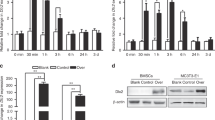Abstract
Osteoblasts and chondrocytes arise from common bipotential mesenchymal progenitor cells. Although the differentiation of these two cell lineages can be induced by treatment with bone morphogenetic proteins (BMPs), the responses of mesenchymal progenitors to BMP differ from cell line to cell line. Here we demonstrate that C3H/10T1/2 cells preferred chondrogenic differentiation, primary bone marrow stroma cells (MSCs) tended to convert to osteoblasts, and ST-2 cells differentiated into both the osteoblastic and chondrocytic lineages simultaneously, suggesting that a molecular switch functions to select cell fate. Osterix, the secondary master regulator of osteoblastogenesis, was induced by BMP at high and low levels in MSCs and ST-2 cells, respectively; in contrast, C3H/10T1/2 cells demonstrated only faint expression. As osterix has been suggested as a negative regulator of chondrogenesis, we hypothesized that the intense chondrocyte differentiation of C3H/10T1/2 cells may have resulted from an absence of osterix. We therefore restored osterix gene expression in C3H/10T1/2 cells using an adenovirus vector. Following BMP treatment, infection with an osterix-encoding virus dramatically inhibited the chondrocytic differentiation of C3H/10T1/2 cells, resulting instead in prominent osteoblast differentiation. These results indicate the chondrogenic potential of C3H/10T1/2 cells was abrogated by osterix expression. Chondrocyte differentiation of MSCs, however, was not enhanced by silencing the osterix gene using lentivirus-mediated shRNA, despite successful suppression of osteoblast differentiation. These results suggest that the low levels of osterix expression remaining after knockdown are sufficient to block chondrogenesis, whereas higher expression may be required to promote osteoblastic differentiation.





Similar content being viewed by others
References
Pittenger MF, Mackay AM, Beck SC, Jaiswal RK, Douglas R, Mosca JD, Moorman MA, Simonetti DW, Craig S, Marshak DR (1999) Multilineage potential of adult human mesenchymal stem cells. Science 284:143–147
Reddi AH (1998) Role of morphogenetic proteins in skeletal tissue engineering and regeneration. Nat Biotechnol 16:247–252
Miyazono K, Maeda S, Imamura T (2005) BMP receptor signaling: transcriptional targets, regulation of signals, and signaling cross-talk. Cytokine Growth Factor Rev 16:251–263
Wozney JM, Rosen V (1998) Bone morphogenetic protein and bone morphogenetic protein gene family in bone formation and repair. Clin Orthop Relat Res 346:26–37
Valentin-Opran A, Wozney J, Csimma C, Lilly L, Riedel GE (2002) Clinical evaluation of recombinant human bone morphogenetic protein-2. Clin Orthop Relat Res 395:110–120
Maeda S, Hayashi M, Komiya S, Imamura T, Miyazono K (2004) Endogenous TGF-β signaling suppresses maturation of osteoblastic mesenchymal cells. EMBO J 23:552–563
Komori T, Yagi H, Nomura S, Yamaguchi A, Sasaki K, Deguchi K, Shimizu Y, Bronson RT, Gao YH, Inada M, Sato M, Okamoto R, Kitamura Y, Yoshiki S, Kishimoto T (1997) Targeted disruption of Cbfa1 results in a complete lack of bone formation owing to maturational arrest of osteoblasts. Cell 89:755–764
Ducy P, Zhang R, Geoffroy V, Ridall AL, Karsenty G (1997) Osf2/Cbfa1: a transcriptional activator of osteoblast differentiation. Cell 89:747–754
Shirakawa K, Maeda S, Gotoh T, Hayashi M, Shinomiya K, Ehata S, Nishimura R, Mori M, Onozaki K, Hayashi H, Uematsu S, Akira S, Ogata E, Miyazono K, Imamura T (2006) CCAAT/enhancer-binding protein homologous protein (CHOP) regulates osteoblast differentiation. Mol Cell Biol 26:6105–6116
Hayashi M, Maeda S, Aburatani H, Kitamura K, Miyoshi H, Miyazono K, Imamura T (2008) Pitx2 prevents osteoblastic transdifferentiation of myoblasts by bone morphogenetic proteins. J Biol Chem 283:565–571
Nakashima K, Zhou X, Kunkel G, Zhang Z, Deng JM, Behringer RR, de Crombrugghe B (2002) The novel zinc finger-containing transcription factor osterix is required for osteoblast differentiation and bone formation. Cell 108:17–29
Kaback LA, Soung Do Y, Naik A, Smith N, Schwarz EM, O’Keefe RJ, Drissi H (2008) Osterix/Sp7 regulates mesenchymal stem cell mediated endochondral ossification. J Cell Physiol 214:173–182
Bobick BE, Kulyk WM (2004) The MEK-ERK signaling pathway is a negative regulator of cartilage-specific gene expression in embryonic limb mesenchyme. J Biol Chem 279:4588–4595
Bi W, Deng JM, Zhang Z, Behringer RR, de Crombrugghe B (1999) Sox9 is required for cartilage formation. Nat Genet 22:85–89
Ulsamer A, Ortuno MJ, Ruiz S, Susperregui AR, Osses N, Rosa JL, Ventura F (2008) BMP-2 induces osterix expression through upregulation of DLX5 and its phosphorylation by p38. J Biol Chem 283:3816–3826
Akiyama H, Kim JE, Nakashima K, Balmes G, Iwai N, Deng JM, Zhang Z, Martin JF, Behringer RR, Nakamura T, de Crombrugghe B (2005) Osteo-chondroprogenitor cells are derived from Sox9 expressing precursors. Proc Natl Acad Sci USA 102:14665–14670
Zhou G, Zheng Q, Engin F, Munivez E, Chen Y, Sebald E, Krakow D, Lee B (2006) Dominance of SOX9 function over RUNX2 during skeletogenesis. Proc Natl Acad Sci USA 103:19004–19009
Zehentner BK, Dony C, Burtscher H (1999) The transcription factor Sox9 is involved in BMP-2 signaling. J Bone Miner Res 14:1734–1741
Takahashi K, Yamanaka S (2006) Induction of pluripotent stem cells from mouse embryonic and adult fibroblast cultures by defined factors. Cell 126:663–676
Takahashi K, Tanabe K, Ohnuki M, Narita M, Ichisaka T, Tomoda K, Yamanaka S (2007) Induction of pluripotent stem cells from adult human fibroblasts by defined factors. Cell 131:861–872
Acknowledgments
This work was supported by grants-in-aid for scientific research from the Ministry of Education, Culture, Sports, Science, and Technology of Japan (T.I. and S.M.). We thank Y. Yuuki, A. Hanyu, N. Kaneniwa, and E. Kobayashi (The Cancer Institute) for their excellent technical assistance.
Author information
Authors and Affiliations
Corresponding author
About this article
Cite this article
Tominaga, H., Maeda, S., Miyoshi, H. et al. Expression of osterix inhibits bone morphogenetic protein-induced chondrogenic differentiation of mesenchymal progenitor cells. J Bone Miner Metab 27, 36–45 (2009). https://doi.org/10.1007/s00774-008-0003-0
Received:
Accepted:
Published:
Issue Date:
DOI: https://doi.org/10.1007/s00774-008-0003-0




